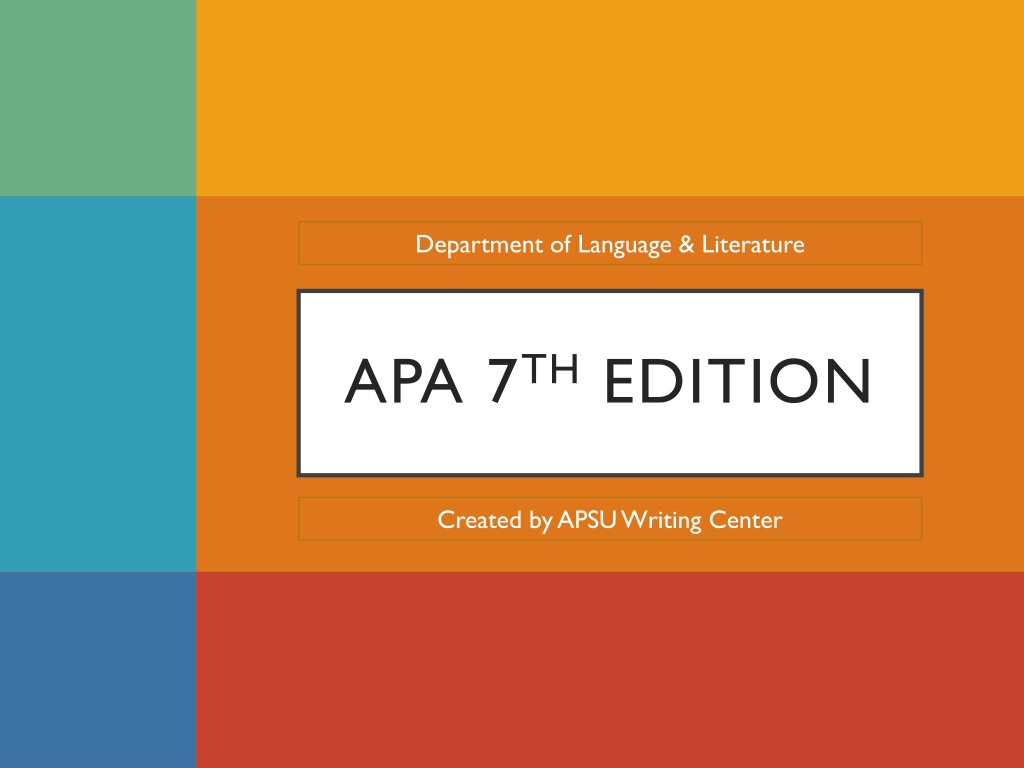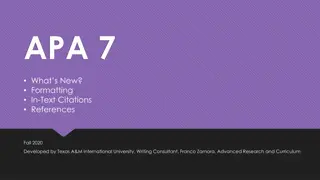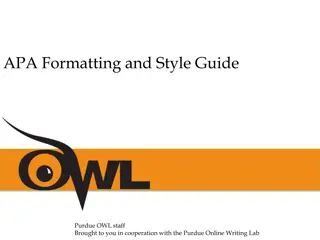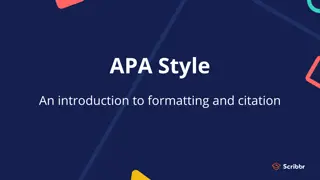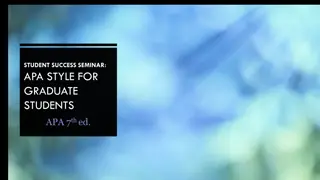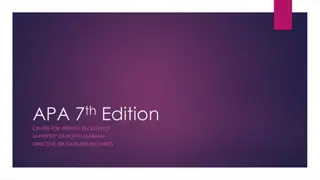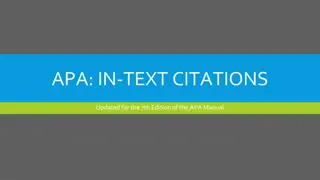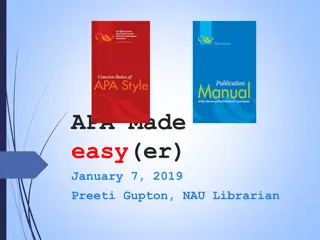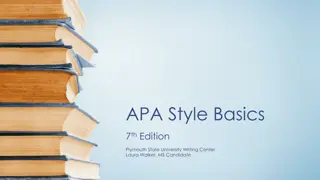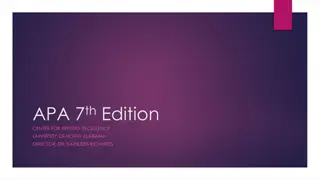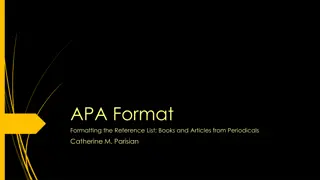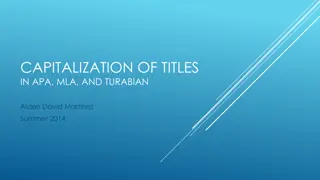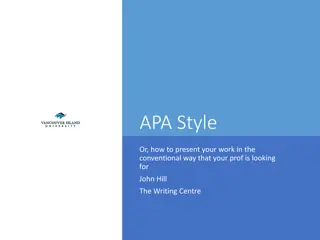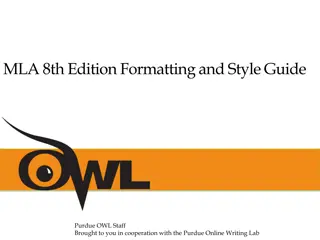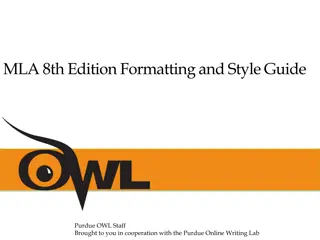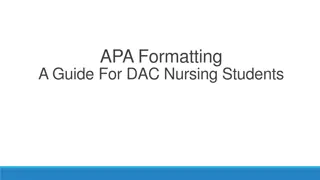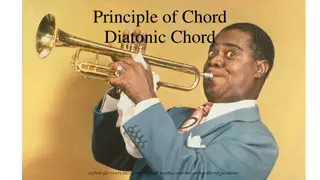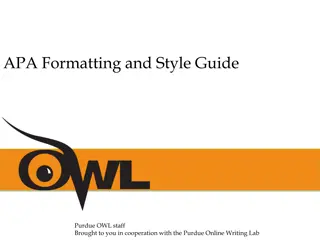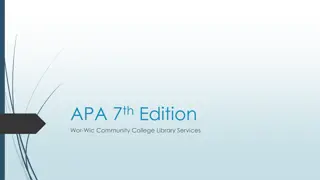Formatting Guidelines for APA 7th Edition Papers
Learn about the general formatting guidelines for APA 7th edition papers, including margins, paragraph settings, font type and size, header formatting, running head and page numbers, title page elements, heading instructions, and tips for creating an effective title.
Download Presentation

Please find below an Image/Link to download the presentation.
The content on the website is provided AS IS for your information and personal use only. It may not be sold, licensed, or shared on other websites without obtaining consent from the author. Download presentation by click this link. If you encounter any issues during the download, it is possible that the publisher has removed the file from their server.
E N D
Presentation Transcript
Department of Language & Literature APA 7THEDITION Created by APSU Writing Center
American Psychological Association (APA) Used in many disciplines Nursing Sociology Education Psychology Social Work Communications Latest updated edition is the 7th edition, dated 2019
General Formatting Guidelines Margins All margins: 1-inch Paragraph Settings Left-Aligned, Unjustified Indent paragraphs inch. Double space throughout the entire paper. Set default settings in Microsoft Word to 0 and check the box Don t add space between paragraphs of the same style. Font Type and Size Calibri 11, Arial 11, Lucida Sans Unicode 10, Times New Roman 12, and Georgia 11. Use one space after the end of each sentence.
Header The header of every page. Formatting: Cannot exceed 50 characters, including spaces and punctuation. If the title is long, use a shortened title. Type the title in all capital letters after typing Running head in lowercase letters. Word head is not capitalized. Running head: is not required for student papers.
Running Head and Page Numbers Header title: flush against the upper-left margin. Page numbers: flush against the upper-right margin. Both should appear on every page of the document beginning with title page.
Example of Running Head Running head: APA STYLE OF FORMATTING PAPERS 1
Title Page Title page includes five elements: Running head Page number Title (12 words or less) Author s name University affiliation If required by the professor, the affiliation can be replaced with the course name and number. An author s note may also be included, but only if the professor requests it.
Heading Horizontally center the title between the left and right margins. Position it vertically in top third of the page. Follow with your name and university affiliation. Double-space these three lines.
The Title Concisely state main idea of the paper. Use no more than 12 words. It may be written on two lines if title too long. If your title is too long, shorten it. Title Page Title: Specific Classroom Techniques for Left-handed Students in a High School Art Course Header Title: CLASSROOM TECHNIQUES FOR LEFT-HANDED STUDENTS
Title Page Example Running head: APA STYLE OF FORMATTING PAPERS 1 APA Style of Formatting Papers Tiberius P. Herman Austin Peay State University
The Body Of The Paper The header after page one should no longer contain Running head: . After inserting the header in Word, select the option Different First Page. For your first page of content, the running head should have the title in all capital letters, and the page number will begin with 2. You will have to type this into the second page header.
Example Header For Page 2 and Forward APA STYLE OF FORMATTING PAPERS 2
The Body Title Center the paper s full title (in uppercase and lowercase letters) on the first line below the running head on page 2 only. Pagination Body of the paper begins on a new page (page 2). Maintain the running head on subsequent pages.
The Abstract An abstract is a summary of the essay/research. Should include a brief description of the problem being investigated, the methods used, the results, and their implications. Includes keywords which identify the content covered and discussed. Function like hashtags
Abstract Format Only appears on the second page. Center the word Abstract at the top of the page. One paragraph No indent needed Must be 150-250 words Ends with keywords (optional)
Example of an APA Style Paper
Documenting Sources Citing: giving credit to sources of ideas, facts, graphics, tables, etc., that are not one s own. Plagiarism: failure to cite, even accidently Using other s work Using your previous work Two types of citations for APA format: Parenthetical or in-text References page
Parenthetical (In-text) Citations Parenthetical citing is citing sources within the body of the paper. APA requires the author s/authors last name(s), year of publication, and the page number. If the source is not paginated, only the name/s and the year of publication are required. Examples (Adams, 1979, p. 42) (Prefect, 2004) Adams (1979) presented the answer to life, the universe, and everything (p. 42).
Parenthetical Citations One author (Smith, 2018, p. 33) Two authors (Zhou & Lopez, 2019, pp. 65-66) Three or more (Miller et al., 2017) et al. is used for every use of the citation.
Parenthetical Citations If no author is identified, use the first few words of the title in place of the author. If no date is provided, use "n.d." in place of the date. Example: Changes in Americans' views of gender status differences have been documented ( Gender and Society, n.d.).
Parenthetical Citations Parenthetical citations in APA 7th ed. are to be in the following format: (Last name, year published, page number) Zombies eat brains (Smith, 2012, p. 87) Or According to Smith (2012), zombies eat brains (p. 87). What appears within the sentence does not appear in the parenthetical citation.
Parenthetical Citations Use and if the authors names are in the sentence. Lewis and Johnson s (2006) study concluded, Students often had difficulty using APA style, especially while citing sources for the first time (p. 64). Use the ampersand (&) if their names are in the parenthetical citation. The educators study concluded, Students often had difficulty using APA style, especially while citing sources for the first time (Lewis & Johnson, 2006, p. 64).
References Page Cited sources in the body of paper need to be listed on the References page. The References page: a bibliographical list of all sources used in the body of the paper goes on a separate page of its own, even if there is space left after the closing paragraph numbered as part of the entire paper as the last page of the document
Formatting the References Page Maintain running head, page numbers, margins, and spacing. Label and center the top of paper with the heading: References (multiple sources) Reference (for one source) Alphabetize sources by the first element in the entry. There is a button in Microsoft Word for this function (the Sort tool) in the Paragraph settings above the Paint Can tool. In the dialogue box, choose sort by Paragraphs and set the type to Text. Text only sorts by letters, so sources that begin with punctuation have to be moved manually.
Formatting the References Page Use hanging indents for each entry. First line of each entry is flush left against margin. Second and subsequent lines are indented one-half inch. To do this, highlight your sources, right-click, choose Paragraph , go to Indentation, find Special, and set it to Hanging.
References Page If listing by the author s name author s name is inverted (last name, first initial, middle initial) Example: Berry, T. J. If a work has more than one author Invert all of the authors names. Follow with a comma; insert the & before name of last author. Example: Berry, T. J., Format, O. K., & Modern, M.
Basic Structure For Referencing Sources Formatting depends on the type of source. All basic formats begin with author s last name and first initials date of publication in parentheses title
Citing: Book Author s last name, first and middle initial. (year). Title of book. Publisher s name. APA STYLE OF FORMATTING 4 Reference Modern, J. (2011). APA is better than MLA. Longman.
Citing: Website Author s last name, first initial. (Publication date). Article title. Name of Website. URL Author s last name, first initial. (Publication date). Article title. Name of Website. Retrieved Date from URL The retrieved from date is only needed when there is no published date for ALL electronic sources. APA STYLE OF FORMATTING 4 References Schierholz, C. (2015). NASA releases plan outlining next steps in journey to Mars. NASA. https://www.nasa.gov/press-release/nasa-releases-plan-outlining-next-steps-in-the-journey- to-mars Hur, J. (n.d.). History of mobile cell phones: The first cell phone to present time. BeBusinessed. Retrieved January 23, 2020 from https://bebusinessed.com/history/history-cell-phones/
Citing: Journal Article Accessed Online Author(s) last name, first and middle initials. (year of publication). Title of article. Name of Journal, Volume(Issue Number), page range. doi link or (Retrieved from date)URL APA REFERENCE EXAMPLES 4 References Brownlie, D. (2007). Toward effective poster presentations: An annotated bibliography. European Journal of Marketing, 41, 1245-1283. https://doi.org/10.1108/03090560710821161 Smyth, A. M., Parker, A. L., & Pease, D. L. (2002). A study of enjoyment of peas. Journal of Abnormal Eating, 8(3), 120-125. Retrieved November 12, 2018 from http://www.articlehomepage.com/full/url/
Citing: eBook Author s last name, first and middle initial. (year). Title of book. Publisher s name. Website name. URL. APA STYLE OF FORMATTING 4 Reference Carroll, L. (1917). Alice s adventures in Wonderland. MacMillan & Co. Google Play Books. https://play.google.com/books/reader?id=Y7sOAAAAIAAJ&pg=GBS.PP11.w.1.0.0.1
Student Resources For more APA resources, visit the Writing Center s website: Google APSU Writing Resources. Check out the many resources available to you online! APA Blog
